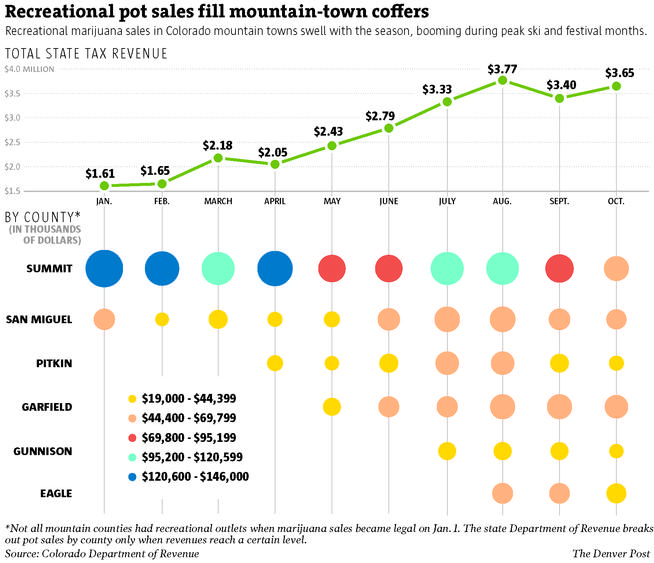Mountain towns dependent on tourists are reaping the rewards of legal marijuana. As the towns swell with visitors — skiers in February and March, summer vacationers in July and August — so do their sales-tax coffers.
“Most of our sales seem to be to our visitors,” said John Warner, a dentist and the mayor of Breckenridge, which is tracking toward $8.8 million in marijuana sales in 2014. “Some people might think of it as a sin tax, and a lot of people don’t like sin taxes. But it’s certainly helpful to our community.”
Video of a pot tour: Pot tourism grows in Colorado even as officials refuse to endorse it
Like a lodging tax that doesn’t burden locals, taxes on marijuana in the high country largely are paid by tourists. A midsummer report by the state Department of Revenue estimated that visitors in highly trafficked mountain communities accounted for 90 percent of marijuana sales.
Year in review
The big picture: How Colorado’s cannabis experiment put the state into a global spotlight
$573 million in pot sales: Here are 12 stats that define the year in marijuana
Follow The Cannabist on Twitter and Facebook
With little history for revenue projections, most town leaders estimated marijuana tax income conservatively. They relished their early Christmas presents, with revenues climbing well beyond early predictions.
Breckenridge’s revenue is about 30 percent higher than Warner and his team expected. The town council recently decided to direct extra marijuana income toward preschool and child care programs, with the rest of the excise tax going toward law enforcement and local mental health programs.
The town is projecting about $8.3 million in 2015 marijuana sales, but that figure may have to be revised downward, Warner said. Voters this month in Breckenridge decided to ban recreational marijuana shops on Main Street, which will push out the town’s marijuana workhorse, Cannabis Club.
“They are the prime generator of these big revenues, and they may not see as large sales figures next year in a new location,” Warner said.
Aspen’s five medical and recreational marijuana dispensaries also are fueling a surge in the city’s tax revenues. The city merges marijuana tax with liquor taxes, but the combined revenue is up 24 percent through October compared with the same span last year.
Denver pot tourism guide: Useful info for toking travelers
Liquor and marijuana sales through October in Aspen are $10.8 million, compared with $7.2 million in 2013, $6.9 million in 2012 and $6.6 million in 2011.
In Telluride, which joined Breckenridge as the only high country hamlet with open stores Jan. 1, tax revenues from three dispensaries are helping pay down the town’s $20 million debt on a development-blocking conservation easement on the beloved valley floor.
While Telluride will post a record sales tax harvest in 2014, marijuana taxes account for only 4.5 percent of all sales tax revenues. Steep declines in marijuana sales from March to the slow-season April and September to festival-free October in Telluride jibe with the statewide trend that most high-country sales are to visitors.
“Really, we are experiencing the benefits of having a balanced economy,” Telluride Mayor Stu Fraser said. “Where we have been able to expand into the shoulder seasons and have grown the winter and summer as well. If I had to point to reason for our growth, it wouldn’t be marijuana.”

